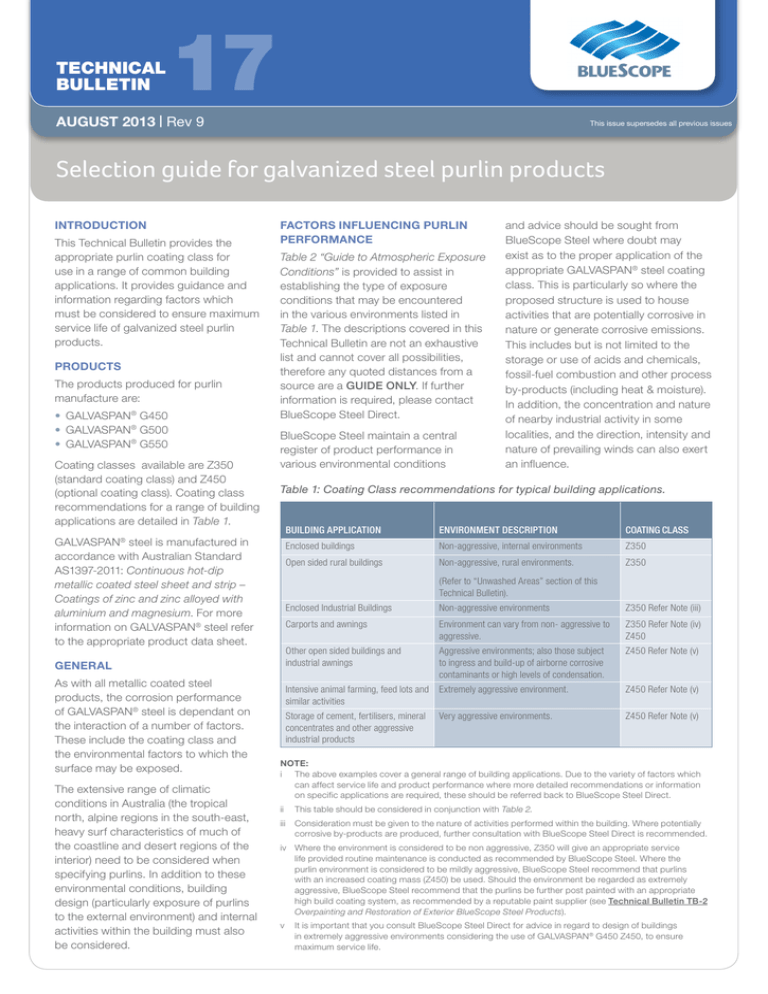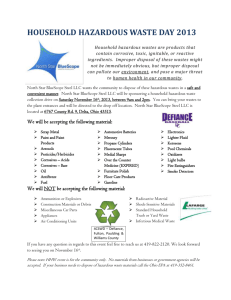
TECHNICAL
BULLETIN
17
AUGUST 2013 | Rev 9
This issue supersedes all previous issues
Selection guide for galvanized steel purlin products
INTRODUCTION
This Technical Bulletin provides the
appropriate purlin coating class for
use in a range of common building
applications. It provides guidance and
information regarding factors which
must be considered to ensure maximum
service life of galvanized steel purlin
products.
PRODUCTS
The products produced for purlin
manufacture are:
• GALVASPAN® G450
• GALVASPAN® G500
• GALVASPAN® G550
Coating classes available are Z350
(standard coating class) and Z450
(optional coating class). Coating class
recommendations for a range of building
applications are detailed in Table 1.
GALVASPAN® steel is manufactured in
accordance with Australian Standard
AS1397-2011: Continuous hot-dip
metallic coated steel sheet and strip –
Coatings of zinc and zinc alloyed with
aluminium and magnesium. For more
information on GALVASPAN® steel refer
to the appropriate product data sheet.
GENERAL
As with all metallic coated steel
products, the corrosion performance
of GALVASPAN® steel is dependant on
the interaction of a number of factors.
These include the coating class and
the environmental factors to which the
surface may be exposed.
The extensive range of climatic
conditions in Australia (the tropical
north, alpine regions in the south-east,
heavy surf characteristics of much of
the coastline and desert regions of the
interior) need to be considered when
specifying purlins. In addition to these
environmental conditions, building
design (particularly exposure of purlins
to the external environment) and internal
activities within the building must also
be considered.
FACTORS INFLUENCING PURLIN
PERFORMANCE
Table 2 “Guide to Atmospheric Exposure
Conditions” is provided to assist in
establishing the type of exposure
conditions that may be encountered
in the various environments listed in
Table 1. The descriptions covered in this
Technical Bulletin are not an exhaustive
list and cannot cover all possibilities,
therefore any quoted distances from a
source are a GUIDE ONLY. If further
information is required, please contact
BlueScope Steel Direct.
BlueScope Steel maintain a central
register of product performance in
various environmental conditions
and advice should be sought from
BlueScope Steel where doubt may
exist as to the proper application of the
appropriate GALVASPAN® steel coating
class. This is particularly so where the
proposed structure is used to house
activities that are potentially corrosive in
nature or generate corrosive emissions.
This includes but is not limited to the
storage or use of acids and chemicals,
fossil-fuel combustion and other process
by-products (including heat & moisture).
In addition, the concentration and nature
of nearby industrial activity in some
localities, and the direction, intensity and
nature of prevailing winds can also exert
an influence.
Table 1: Coating Class recommendations for typical building applications.
BUILDING APPLICATION
ENVIRONMENT DESCRIPTION
COATING CLASS
Enclosed buildings
Non-aggressive, internal environments
Z350
Open sided rural buildings
Non-aggressive, rural environments.
Z350
(Refer to “Unwashed Areas” section of this
Technical Bulletin).
Enclosed Industrial Buildings
Non-aggressive environments
Z350 Refer Note (iii)
Carports and awnings
Environment can vary from non- aggressive to
aggressive.
Z350 Refer Note (iv)
Z450
Other open sided buildings and
industrial awnings
Aggressive environments; also those subject
to ingress and build-up of airborne corrosive
contaminants or high levels of condensation.
Z450 Refer Note (v)
Intensive animal farming, feed lots and Extremely aggressive environment.
similar activities
Z450 Refer Note (v)
Storage of cement, fertilisers, mineral
concentrates and other aggressive
industrial products
Z450 Refer Note (v)
Very aggressive environments.
Note:
iThe above examples cover a general range of building applications. Due to the variety of factors which
can affect service life and product performance where more detailed recommendations or information
on specific applications are required, these should be referred back to BlueScope Steel Direct.
iiThis table should be considered in conjunction with Table 2.
iiiConsideration must be given to the nature of activities performed within the building. Where potentially
corrosive by-products are produced, further consultation with BlueScope Steel Direct is recommended.
ivWhere the environment is considered to be non aggressive, Z350 will give an appropriate service
life provided routine maintenance is conducted as recommended by BlueScope Steel. Where the
purlin environment is considered to be mildly aggressive, BlueScope Steel recommend that purlins
with an increased coating mass (Z450) be used. Should the environment be regarded as extremely
aggressive, BlueScope Steel recommend that the purlins be further post painted with an appropriate
high build coating system, as recommended by a reputable paint supplier (see Technical Bulletin TB-2
Overpainting and Restoration of Exterior BlueScope Steel Products).
vIt is important that you consult BlueScope Steel Direct for advice in regard to design of buildings
in extremely aggressive environments considering the use of GALVASPAN® G450 Z450, to ensure
maximum service life.
TECHNICAL BULLETIN TB-17 SELECTION GUIDE FOR GALVANIZED STEEL PURLIN PRODUCTS
There are a number of specific factors
which must be considered:
Regional Influences
Current field experience has indicated
that certain regions in Australia are
more susceptible to problems such as
excessive salt and industrial fallout and
excessive humidity. These influences
can have a detrimental effect on
purlin life which must be taken into
consideration when designing building
structures. Individual areas should be
assessed for local field performance
prior to final specification. Please contact
BlueScope Steel Direct for advice.
Unwashed Areas of Buildings
All surfaces of a building structure
where natural rainfall cannot reach are
subject to the build up of dust, marine
salts, industrial fallout or specific local
environment contaminants. In open
sided buildings this can include the
wind-borne deposits from local industrial
or agricultural activities.
Accelerated corrosion can occur when
these contaminants combine with
night-time condensation resulting in a
corrosive electrolyte that over a period
of time can contribute to corrosion of
galvanized purlins and cladding.
To ensure maximum service life under
such conditions these areas should
be subject to a regular maintenance
programme. Where practical, washing
down of the internal surfaces at regular
intervals should be conducted. The
frequency of washing is dependant
on the local environmental conditions.
Washing may be conducted by means
of high-pressure water jets, nylon
brush cleaning with suitable household
detergent solution followed by rinsing
and drying.
Where consideration is being given to
initial design, which may incorporate
unwashed areas and where such
cleaning methods may not be
appropriate in respect of building
function (for example operations,
contents etc) please contact
BlueScope Steel Direct for advice.
Accumulation of Condensation
or Fallout on Purlins
In applications where there is high
levels of condensation or dust within
the building it is recommended where
possible that purlins be specified with a
2
down turned bottom lip. This will aid with
drainage of moisture from the bottom
flange and help to reduce accumulation
of dust or debris and assist with
maintenance to remove buildup inside
the bottom flange
RELATED BLUESCOPE STEEL
TECHNICAL BULLETINS
Technical Bulletin TB-2
Overpainting and Restoration of Exterior
BlueScope Steel Products
REFERENCED AUSTRALIAN
STANDARDS
• AS 1397-2011 Continuous hot-dip
metallic coated steel sheet and strip –
Coatings of zinc and zinc alloyed with
aluminium and magnesium
NOTE:
All Australian and Australian/New Zealand
Standards should be read to incorporate any and all
amendments to the most recently published version.
Table 2: Guide to atmospheric exposure conditions
Corrosive
Influence
Exposure Condition
Aggressive
(close distances to surf,
industrial pollution and
fumes)
Non-aggressive
(outer urban, semi-rural
areas, well removed from
shoreline and industrial
pollution)
Distance from
Corrosive Influence
Rough, active surf
Salt laden, moist air
500m – 1000m
Industrial emission
Fallout
300m – 750m
Fossil fuel combustion
Acid laden air
300m – 750m
Rough, active surf
Salt laden, moist air
>1000m
Calm, still water
Salt laden, moist air
>300m
Industrial emission
Fallout
>750m
Fossil fuel combustion
Acid laden air
>750m
Note:
iContact BlueScope Steel Direct for exposure classifications which do not meet the above criteria.
iiFor distances less than the minimum shown, please consult BlueScope Steel Direct.
If you have any questions regarding this Bulletin, please contact
BlueScope Steel Direct on 1800 800 789.
To ensure you have the most current Technical Bulletin, please
go to bluescopesteel.com.au.
The information and advice contained in this Technical Bulletin (‘Bulletin’) is of a general nature only and has not been prepared with your specific needs in mind. You should always obtain
specialist advice to ensure that the materials, approach and techniques referred to in this Bulletin meet your specific requirements.
BlueScope Steel Limited makes no warranty as to the accuracy, completeness or reliability of any estimates, opinions or other information contained
in this Bulletin and to the maximum extent permitted by law, BlueScope Steel Limited disclaims all liability and responsibility for any loss or damage,
direct or indirect, which may be suffered by any person acting in reliance on anything contained in or omitted from this Bulletin.
GALVASPAN® and BlueScope are registered trade marks of BlueScope Steel Limited.
© 2013 BlueScope Steel Limited ABN 16 000 011 058. BlueScope Steel (AIS) Pty Ltd ABN 19 000 019 625. All rights reserved.


